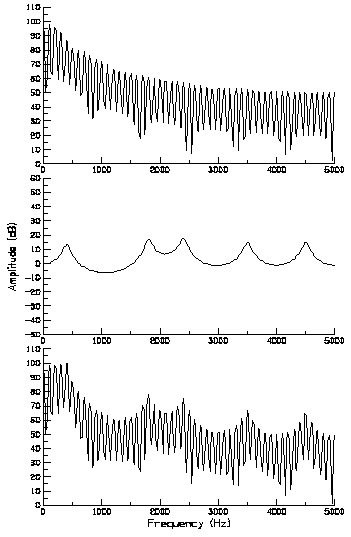Spectral Shaping 
Source Filter Theory
 The cavities of the supra-glottal vocal tract resonate when excited by
sound energy. The exact resonance characteristics of the vocal tract
are a function of many factors, but the two factors of primary
importance are the length of the vocal tract and its shape, that is,
the cross sectional area profile from glottis to lips.
Resonances in the vocal tract reinforce the sound
energy of the source function at particular frequencies. These
frequencies are variously called resonant frequencies, poles, or
formant frequencies. In the figure on the left, we see the effects of
passing a model source function with its dense harmonic structure
through a model vocal tract producing an /ae/-like vowel. The top
panel in this figure shows the spectrum of the source function. The
middle panel in this figure shows the response characteristics of the
vocal tract. This is a relatively smooth and continuous function of
frequency with peaks at frequencies corresponding to the resonant
frequencies of the vocal tract. The bottom panel in this figure shows
the acoustic output from this model. It retains both the fine harmonic
structure of the source and the structure introduced by the resonance
characteristics of the vocal tract.
The cavities of the supra-glottal vocal tract resonate when excited by
sound energy. The exact resonance characteristics of the vocal tract
are a function of many factors, but the two factors of primary
importance are the length of the vocal tract and its shape, that is,
the cross sectional area profile from glottis to lips.
Resonances in the vocal tract reinforce the sound
energy of the source function at particular frequencies. These
frequencies are variously called resonant frequencies, poles, or
formant frequencies. In the figure on the left, we see the effects of
passing a model source function with its dense harmonic structure
through a model vocal tract producing an /ae/-like vowel. The top
panel in this figure shows the spectrum of the source function. The
middle panel in this figure shows the response characteristics of the
vocal tract. This is a relatively smooth and continuous function of
frequency with peaks at frequencies corresponding to the resonant
frequencies of the vocal tract. The bottom panel in this figure shows
the acoustic output from this model. It retains both the fine harmonic
structure of the source and the structure introduced by the resonance
characteristics of the vocal tract.
Example Synthetic Vowels
Here are three examples of vowels produced using the LF source
model. To hear what the vowel sounds like, click on the vowel phonetic
symbol. To see the spectrum, click on the word Spectrum and to
see a graph of the vowel waveform, click on the word Waveform.
References


 The cavities of the supra-glottal vocal tract resonate when excited by
sound energy. The exact resonance characteristics of the vocal tract
are a function of many factors, but the two factors of primary
importance are the length of the vocal tract and its shape, that is,
the cross sectional area profile from glottis to lips.
Resonances in the vocal tract reinforce the sound
energy of the source function at particular frequencies. These
frequencies are variously called resonant frequencies, poles, or
formant frequencies. In the figure on the left, we see the effects of
passing a model source function with its dense harmonic structure
through a model vocal tract producing an /ae/-like vowel. The top
panel in this figure shows the spectrum of the source function. The
middle panel in this figure shows the response characteristics of the
vocal tract. This is a relatively smooth and continuous function of
frequency with peaks at frequencies corresponding to the resonant
frequencies of the vocal tract. The bottom panel in this figure shows
the acoustic output from this model. It retains both the fine harmonic
structure of the source and the structure introduced by the resonance
characteristics of the vocal tract.
The cavities of the supra-glottal vocal tract resonate when excited by
sound energy. The exact resonance characteristics of the vocal tract
are a function of many factors, but the two factors of primary
importance are the length of the vocal tract and its shape, that is,
the cross sectional area profile from glottis to lips.
Resonances in the vocal tract reinforce the sound
energy of the source function at particular frequencies. These
frequencies are variously called resonant frequencies, poles, or
formant frequencies. In the figure on the left, we see the effects of
passing a model source function with its dense harmonic structure
through a model vocal tract producing an /ae/-like vowel. The top
panel in this figure shows the spectrum of the source function. The
middle panel in this figure shows the response characteristics of the
vocal tract. This is a relatively smooth and continuous function of
frequency with peaks at frequencies corresponding to the resonant
frequencies of the vocal tract. The bottom panel in this figure shows
the acoustic output from this model. It retains both the fine harmonic
structure of the source and the structure introduced by the resonance
characteristics of the vocal tract.